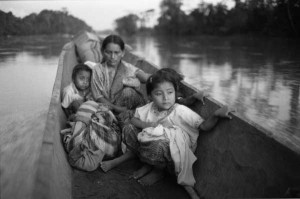Richard Cross Exhibition on Central America to Open at the Museum of Social Justice

One of several images photojournalist Richard Cross took while covering the wars in Central America. An exhibition of his work opens Aug. 15 at the Museum of Social Justice. Photo by Richard Cross, from the collection in CSUN’s Tom & Ethel Bradley Center.
For four years, until his death in 1983, American photojournalist Richard Cross captured the realities of the wars in Central America and their impact on those caught in the crossfire.
An exhibition of his work, “Visualizing the People’s History: Richard Cross’ Images of the Central American Liberation Wars” — organized by California State University, Northridge’s Tom & Ethel Bradley Center — opens Thursday, Aug. 15, at the Museum of Social Justice in downtown Los Angeles. The exhibition is part of center’s work to preserve and disseminate the visual history of the people of Los Angeles, California and the nation.

Richard Cross. Photo courtesy of CSUN’s Tom & Ethel Bradley Center.
“Richard Cross’ photographs easily combine styles of visual journalism, visual anthropology, and art, turning them into powerful images that explore events beyond the immediate drama and focus on deeper patterns to highlight the historical causes of the conflicts,” said CSUN journalism professor José Luis Benavides, director of the Tom & Ethel Bradley Center and co-curator of the exhibition with CSUN art professor Edward Alfano.
Cross documented the turbulent period of liberation wars in Central America from 1979 to 1983, when he was killed while on assignment in Honduras with Los Angeles Times’ Mexico bureau chief, Dial Torgerson, when the car they were riding in struck a land mine. Cross was only 33 years old when he died.
Cross’s photographs depict people, communities and landscapes enduring war and genocide.
“His work illuminates the legacies of these wars, which propelled the largest migration of people from Central America to the United States, which as of 2017 had 5.5 million residents of Central American heritage — a population whose American experience is shaped by the history of those wars,” Benavides said.
In a 1981 conversation with a reporter from the magazine News Photographer, Cross said, “I think photographers sometimes are very short-sighted in looking at causes. They are interested in the more dramatic symptoms of the problem rather than the cause of the problem. There is this sort of refusal to look at patterns.”
Benavides said Cross “created a visual record of the wars that contested the official, dominant narratives at the time.”

Among the photos by Richard Cross on display at the Museum of Social Justice. Courtesy of the Tom & Ethel Bradley Center
“His photographs focus on the visual history of the people — not the leaders — and practice in-depth, contextual photojournalism instead of the dramatic, event-driven photojournalism demanded by U.S. publications,” Benavides said.
The exhibition runs Aug. 15 to Nov. 24. The opening reception is scheduled to take place at 4 p.m. on Saturday, Aug. 17, at the Museum of Social Justice, located at 115 Paseo De La Plaza.
Thanks to a grant by the National Endowment for the Humanities, CSUN’s Tom & Ethel Bradley Center has been digitizing its photographic collection of Richard Cross, including thousands of photos from his work in Nicaragua, El Salvador, Honduras, Guatemala and southern Mexico. These photographs are publicly available at the Oviatt Library’s digital collection site with bilingual metadata at https://digital-library.csun.edu/bradley-center-photographs/richard-cross.
The mission of the Tom & Ethel Bradley Center is to collect, preserve, and disseminate the visual history of Southern California, with an emphasis on ethnic minority communities and photographers. Oral histories, manuscripts and other ephemeral materials support the photographic collection.

Photo by Richard Cross. Courtesy of the Tom & Ethel Bradley Center
The center was established at CSUN in 1981 by journalism professor Kent Kirkton as the Center for Photojournalism and Visual History. In 2008, as its mission and participation broadened, it was renamed the Institute for Arts & Media. After entering into a partnership with the Tom & Ethel Bradley Foundation in 2013, it was renamed as the Tom & Ethel Bradley Center, which presently holds about one million images. Many of the images were produced by African-American freelance and independent photographers in the African-American communities in and near Los Angeles.
Other noteworthy collections held by the center include images by the photographer John Kouns, who spent years documenting two of the most important social movements of the 1960s and 1970s in America, the civil rights struggle in the South and the workers’ and civil rights struggle of the United Farm Workers Union in California; Emmon Clarke, a volunteer photographer for César Chávez and the United Farmworkers during the formative period of the union; and photographer Herb Carleton, who spent his career at the Los Angeles Daily News, starting at the paper when it was known as the Valley News and Green Sheet.
For more information about CSUN’s Tom & Ethel Bradley Center, visit its website at http://www.csun.edu/bradley-center/or call the Center at (818) 677-3037.

 experience
experience